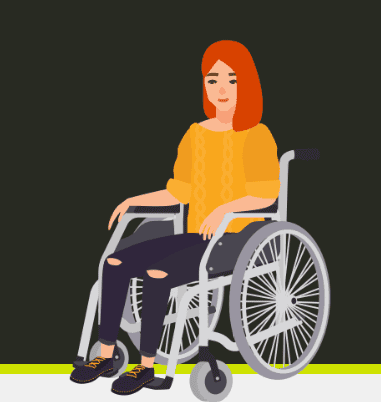For many people, going to court is seen as a necessary evil. It’s a way to help them gain justice, secure compensation or get redress for crimes committed against them or negligent behaviour that has adversely affected them.
But, putting yourself through the court process can be a daunting prospect, with unfamiliar processes, unwritten etiquettes and imposing buildings adding to the fact that there’s often a lot at stake. Your future financial security, physical and mental wellbeing and sense of closure could be riding on a single (or several) court appearance(s). What’s more, for our clients who have issues with their vision or hearing, or those with mental health issues or childcare responsibilities, the process can be even more difficult.
With all this in mind, we looked into the accessibility of courthouses across England, Scotland and Wales. In April 2019, the government admitted that 31 out of 56 courthouses in the Greater London area are deemed inaccessible. So, how do things look like over a year on? And does it differ across Great Britain? Read on to discover the results of our investigation.
Only 2% of courthouses meet all accessibility criteria
When the issue of accessibility in courthouses is discussed, wheelchair access and availability of working lifts tend to be the main factors that are considered.
However, many of our clients face additional barriers as they attempt to pursue justice. Clients who have issues with hearing or seeing may not be aware of all that is being said or done in court. For our clients who have mental health issues or learning difficulties, the court process can bring additional trauma and anxiety. We also have clients who are busy parents, who may find it difficult to juggle childcare with going to court.
We used the government’s Court Tribunal Finder to measure courthouses on 11 different factors relating to a variety of accessibility requirements. Courthouses will be marked as offering the feature if it is explicitly stated within the Finder:
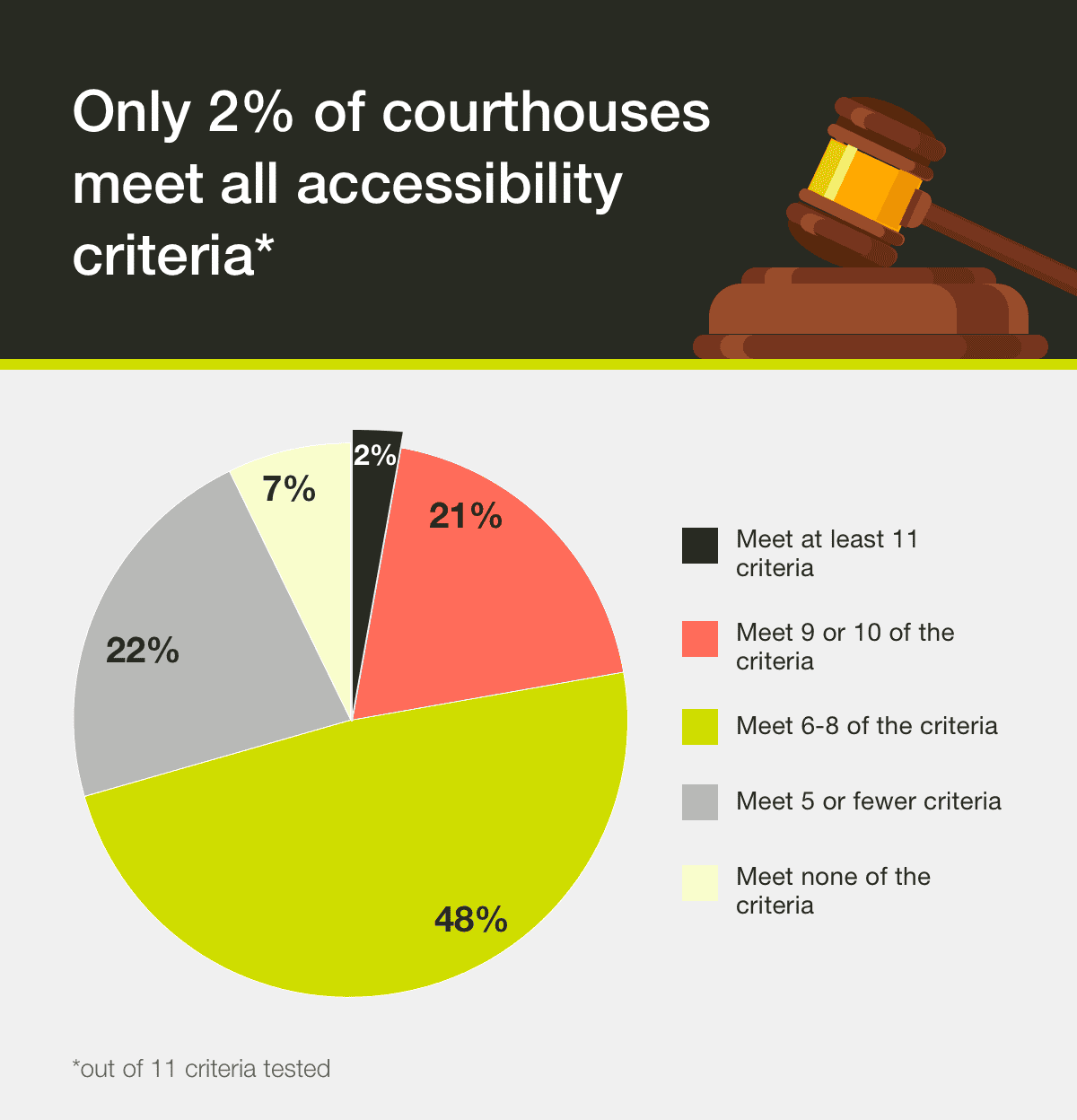
Only 8 of the courthouses tested met all 11 criteria.
Making up just 2% of the 444 courthouses tested, these venues offer wheelchair access, disable parking, accessible toilets, hearing loops, interview rooms, baby changing facilities, video conference facilities, wireless internet access, witness support, lift access and welcome assistance dogs.
Of these, 3 are in South West England, 2 in North West England, and 1 each in the Midlands, Wales and the North East of England.
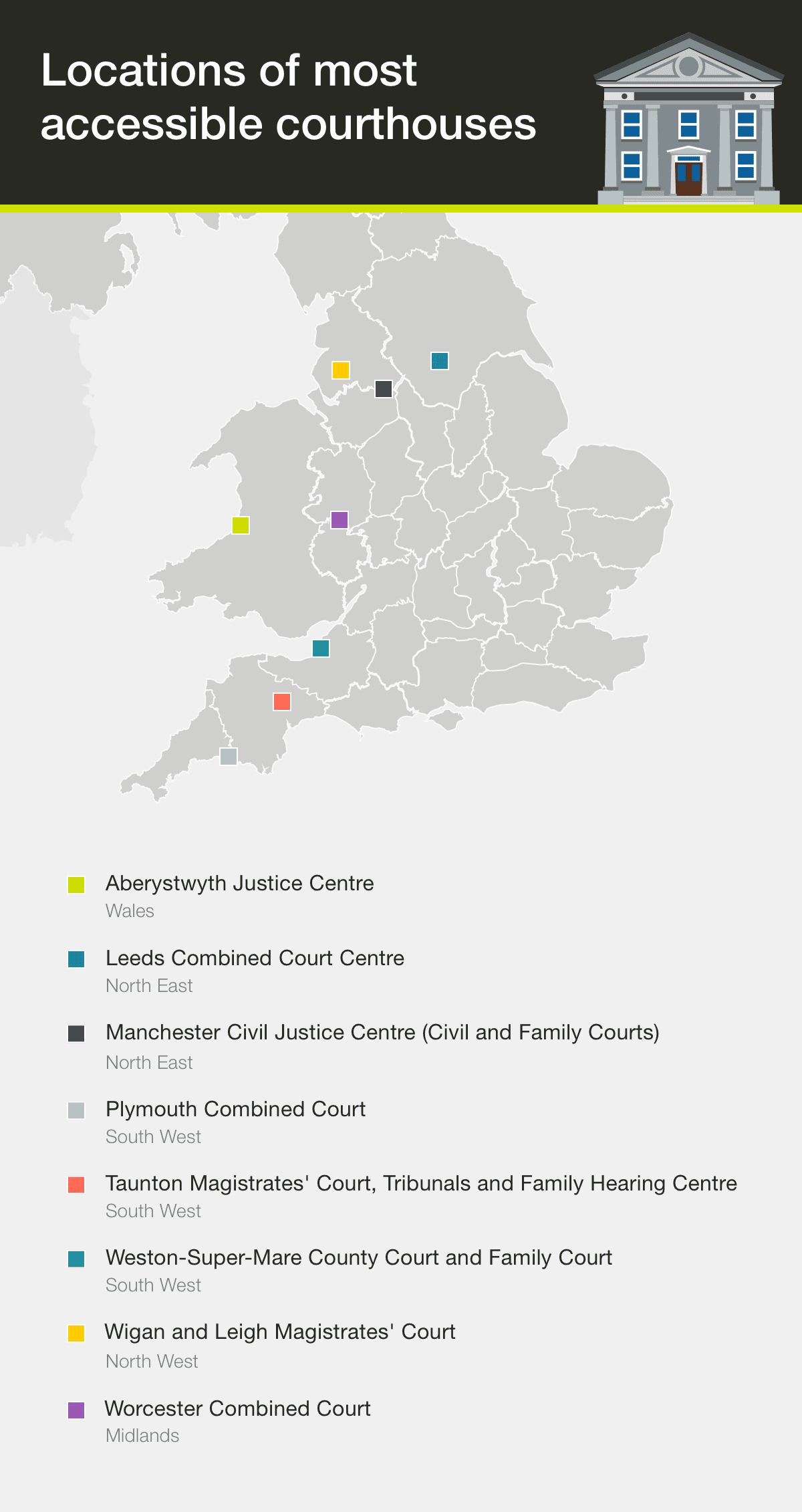
In 2018, the government pledged £15 million in funding to fix court buildings. Although much of the announced maintenance centred around security, CCTV, heating and cooling, the announcement named Snaresbrook Crown Court as undergoing a longer-term refurbishment. This may explain why the courthouse – a Grade II listed building – appears high in our list of accessible courthouses, and heralds promising possibilities for other courts, should they receive the funding and attention they deserve.
The House of Commons Justice Committee’s Court and Tribunal reforms report in October 2019 explained that many people who go to court “have mental and/or physical disabilities and, for them, a long journey to an unfamiliar area—usually undertaken on public transport—is extremely difficult. Other clients have caring responsibilities which make the journey challenging for them.”
Over the past decade, the government has followed a programme of reforms intended to streamline the court process. Two major aspects of the reforms have been reducing the amount of hearings that require you to be physically present at court, and closing and selling court buildings. It’s probably inevitable that, by 2019, many organisations had started to point out the inconvenience of these closures, and how it has affected the journey time for court users.
As the graph above demonstrates, there are very limited options for fully-accessible courthouses in each country – meaning longer travel times may well be a necessity unless a concerted effort is made to improve the existing buildings.
Over three-quarters of courthouses are not fully accessible for wheelchair users
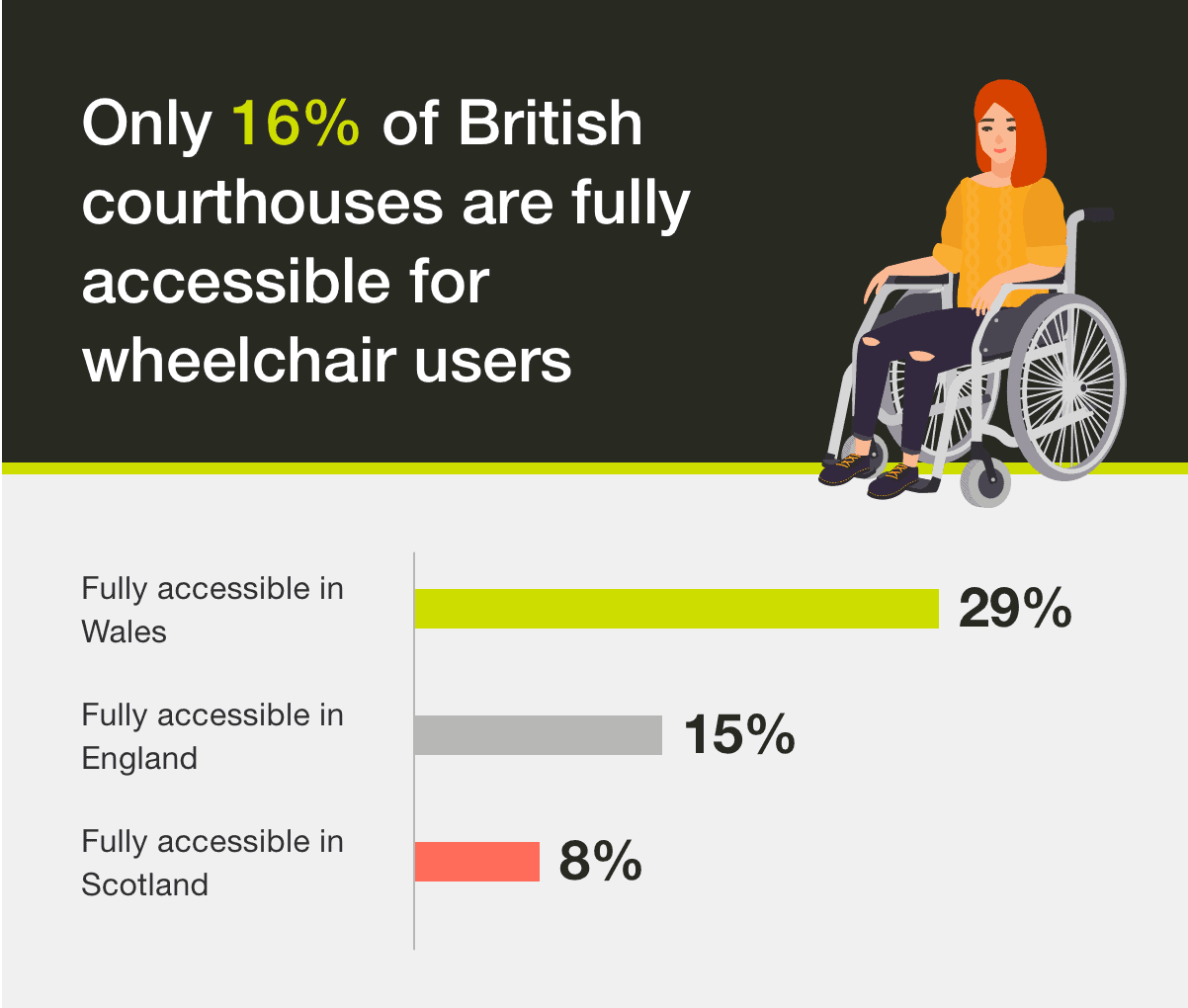
There are three main factors that come into play when it comes to accessibility for people in wheelchairs:
- wheelchair access within the courthouse
- disabled parking spaces near the courthouse
- accessible toilets
Our research found that only 1 courthouse in Scotland meets all three criteria, only 10 courthouses in Wales and just 59 in England. Overall, this means only 16% of courthouses across the three countries are fully accessible for wheelchair users.
And, of course, none of this takes into account the fact that you may find the toilets or lifts are out of service or that all parking spots have been filled on the day of your court appearance. Some courthouses may also have security gates that are too narrow for most wheelchairs.
For our clients who use wheelchairs, all this adds an extra barrier to their access to justice.
Almost 8 in 10 courthouses offer hearing loops and accept assistance dogs
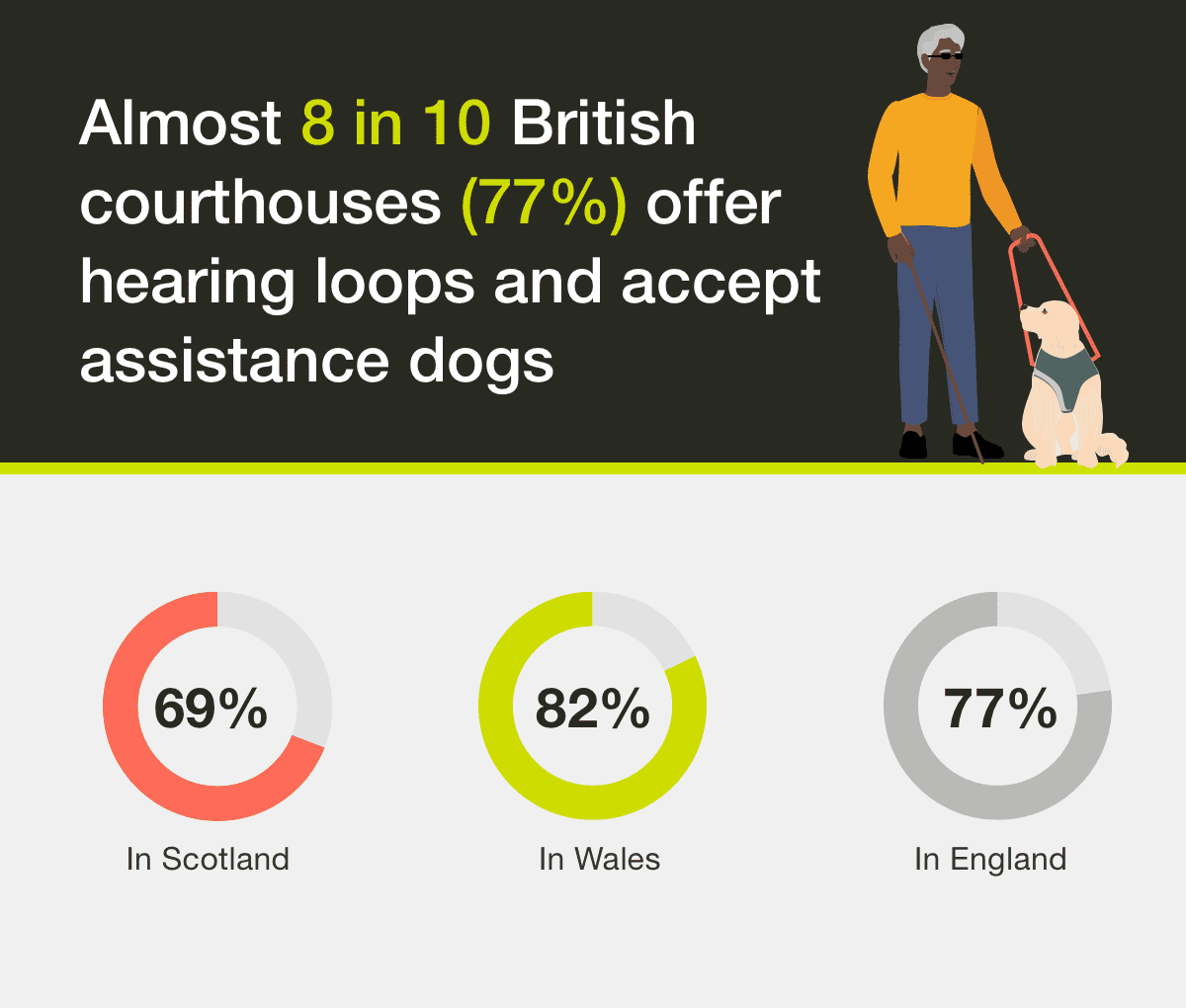
On a more positive note, the majority of courthouses offer hearing aid induction loops and welcome assistance dogs or guide dogs within the building. This is good news for people who are deaf or blind, although there are still some limitations to what is offered.
Three-quarters of the courthouses that do offer hearing aid loops require visitors to contact the court in advance to arrange it, so the court can arrange to hold your visit in a room equipped with the system. And, only 5 courthouses offer portable hearing loops that can be moved with you to where you need to go. Not to mention, of course, that hearing aid loops are only effective for people with some residual hearing. People who have severe or profound hearing loss will need further adjustments to help ensure they don’t miss out on what’s being discussed.
Only 22% of courthouses provide mental health support

Our study found that only 22% of courthouses offer witness care services such as a secure witness suite, access to the Citizens Advice Witness Service, a vulnerable witness waiting area that’s separate from the public waiting area, or a quiet room for people with anxiety and other mental health issues.
While providing witness testimony – or the simple fact that you’re attending court – can be a nerve-wracking experience for anyone, the experience may be compounded for people with mental health issues. A quiet room they can go to for some time alone, such as a separate witness waiting room to help them calm their nerves, can be invaluable in helping ensure people with mental health issues feel as relaxed as possible in court.
However, only 1 out of the 34 courthouses in Wales offers a prayer room or quiet room, while only 9 of the 397 in England offer the same. Similarly, only 9 courthouses in Wales and only 45 courthouses in England offer a witness support suite. It’s imperative that mental health is taken more seriously within the court system to ensure fair treatment for all.
64% of courthouses offer baby changing facilities
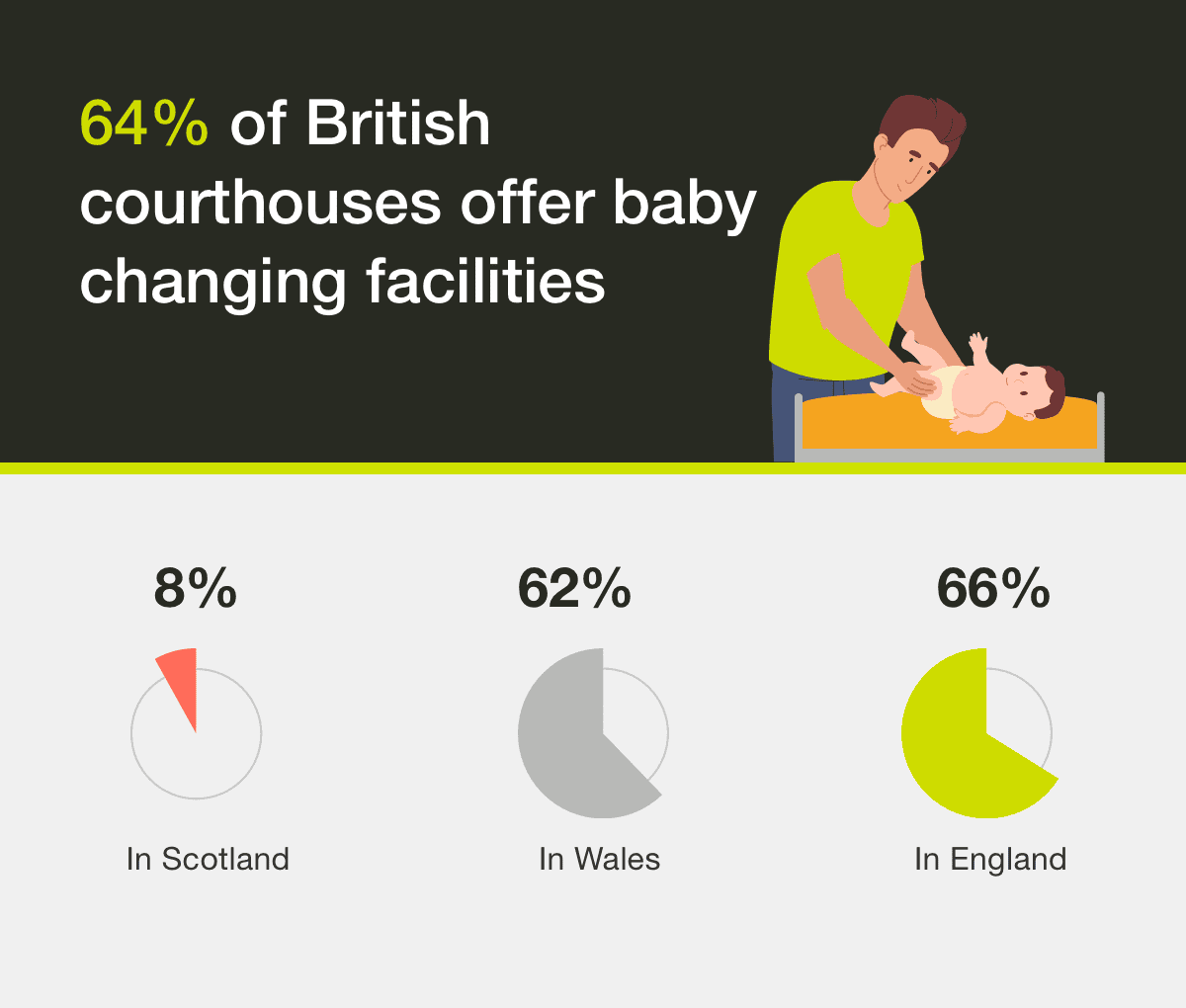
For working parents, needing to appear in court means arranging childcare – which can be cost-prohibitive for those on a lower income. For parents who are unable to arrange childcare, unfortunately only 9% of courthouses offer both a baby changing facility and a children’s room for the young ones to wait in while court proceedings take place.
On a brighter note, 64% of courthouses do offer baby changing facilities, typically located within the disabled toilets. For parents who need to bring their child to court with them, it’s heartening to know that there are some options available – although it may still be difficult to arrange for the child to be occupied when the hearing is in progress.
Conclusion
We see first-hand the difficulties our clients go through before attending court, whether they’ve recently suffered major trauma, or have come to terms with historic issues for which they’ve had to summon a lot of courage to seek redress. Being made uncomfortable in court because the buildings aren’t equipped to handle their disability or other issues adds an extra sense of discomfort, making an already distressing time even more difficult.
It’s also important that the information on official sites such as the Court Tribunal Finder is as accurate and as complete as possible to make things more straightforward for court users. By making a collective effort and covering as many facets of the process as we can, we can help improve access to justice for all.
Methodology
We used the Court Tribunal Finder to collate a list of all 444 available courts in England, Scotland and Wales. Using the same website, we looked at the ‘building facilities’ listed for each court, and noted down 11 separate accessibility factors: wheelchair access, wheelchair parking, assistance/guide dogs, hearing aid loop, interview rooms, baby changing facilities, video conference facilities, accessible toilets, wireless internet access, witness support, and lift availability. Factors would get marked as ‘No’ for the courthouse if information is incomplete or not specified. All data gathered in May-July 2020. This raw data can be found here.
